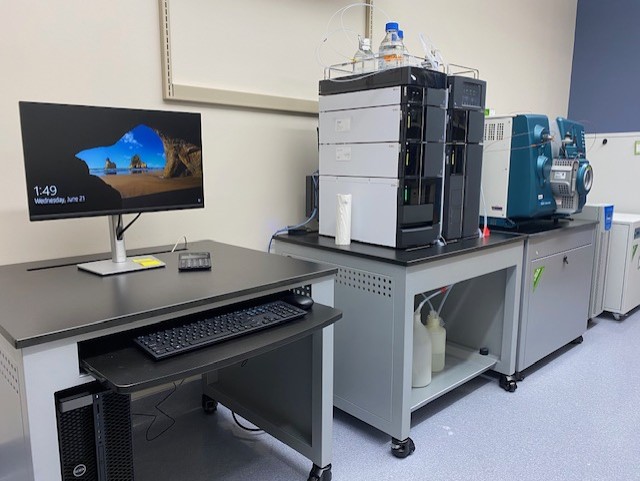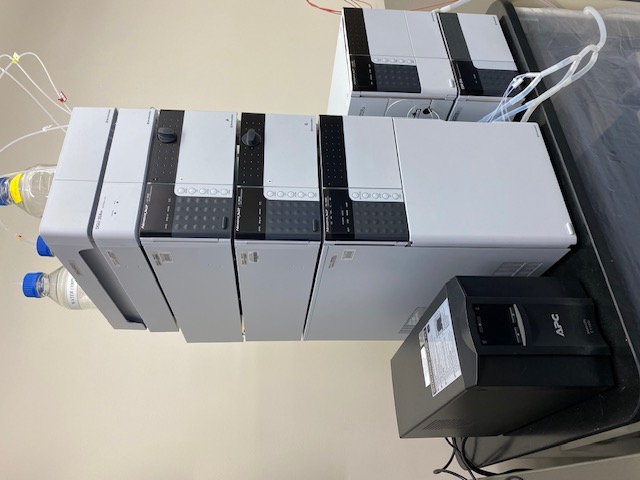West Texas Pharmacology Core
Goals
To provide the most up-to-date technologies and expertise in clinical pharmacology in drug development and clinical trials. The core is funded by CPRIT to enable preclinical and clinical pharmacology studies in pediatric cancer drug development.
Major Instruments


- Sciex Triple Quad 6500 system. This mass spectrometer was recently purchased in support of CPRIT. transferred from TTUHSC El Paso when they surplus Core instruments after 5 years of operation. Unfortunately, we noted that the system did not properly work after the initial set up, failing operational qualifications. Our plan is to trade-in this equipment to reduce the cost of purchasing a new unit if CPRIT funds the core. This would be a major update to our Core.
- Waters Arc HPLC systems with DAD and FLD. Empower software for the operation.
- Shimadzu L20 HPLC system. This system was donated by a private foundation about a decade ago. The unit is utilized when one of the Agilent 1200 systems are in repair. This is an old model and needs software updates.
Technical Expertise
-
Bioanalytical assay development supporting clinical trials:The exemplary analytical assays developed by our laboratory to detect drugs and metabolites for preclinical and clinical studies are listed below.[1-14] For example, the PI developed a mass spectrometry assay to measure MM-398 (nanoliposomal irinotecan) and its metabolites (SN-38 and SN-38 glucuronide) in mouse plasma, major organs, and tumors, which together with preclinical activity and mechanism data[8] led to an ongoing SPOC pediatric phase I clinical trial (NCT02013336). The phase I trial recently completed the dose-escalation phase, and PK data provided by the PI was instrumental in guiding the conduct of an ongoing expansion study in responding histologies which will inform possible Children’s Oncology Group phase II study designs.
- Drug metabolism studies: Drug metabolism studies conducted in a sequence of in vitro experiments of phase I and phase II metabolism and in vivo characterization of drug metabolism is informative and time- and cost-saving. Phase I and phase II drug metabolism studies using both human and mouse liver microsomes and in enzyme induction assays using hepatocytes.[1, 4, 7] An example of clinical translation of metabolism studies was the use of ketoconazole to inhibit metabolism of fenretinide.[15] In the initial fenretinide pediatric phase I trial,[16] a novel formulation was shown to achieve higher exposures than the old capsule formulation, but higher levels (to improve anticancer activity) was sought. A subsequent clinical study that ketoconazole enhanced fenretinide exposures in children receiving oral fenretinide.[17]
- Pharmacokientics profiling: We characterize PK parameters using PK software, such as ADAPT and WinNonlin and model to decide dosing schedules or determine anticipated concentrations based on the parameter priories.[2, 4, 6, 18]
- GLP and non-GLP analysis: The core laboratory provides access to GLP and non-GLP analysis of small molecules and antibodies.


Contact
Min H. Kang, PharmD
Examples of Publications Supported by this Core
[1] P. Sonawane, H.E. Cho, A. Tagde, D. Verlekar, A.L. Yu, C.P. Reynolds, M.H. Kang, Metabolic characteristics of 13-cis-retinoic acid (isotretinoin) and anti-tumour activity of the 13-cis-retinoic acid metabolite 4-oxo-13-cis-retinoic acid in neuroblastoma, British Journal of Pharmacology, 171 (2014) 5330-5344.
[2] V. Sandor, S. Bakke, R.W. Robey, M.H. Kang, M.V. Blagosklonny, J. Bender, R. Brooks, R.L. Piekarz, E. Tucker, W.D. Figg, K.K. Chan, B. Goldspiel, A.T. Fojo, S.P. Balcerzak, S.E. Bates, Phase I trial of the histone deacetylase inhibitor, depsipeptide (FR901228, NSC 630176), in patients with refractory neoplasms, Clin Cancer Res, 8 (2002) 718-728.
[3] H. Cho, A. Naranjo, C. Van Ryn, S. Yang, P. Sonawane, J.G. Villablanca, Yu, A.L., J.R. Park, S. Kreissman, C.P. Reynolds, M.H. Kang, Low plasma levels of 13-cis-retinoic acid (isotretinoin) and its active metabolite 4-oxo-13-cis-retinoic acid are associated with lower overall survival of high-risk neuroblastoma patients, Proceedings of the 108th Annual Meeting of the American Association for Cancer Research, AACR 2017 (2017).
[4] H.E. Cho, M.H. Kang, Analysis of fenretinide and its metabolites in human plasma by liquid chromatography-tandem mass spectrometry and its application to clinical pharmacokinetics, J. Pharm. Biomed. Anal, 132 (2017) 117-124.
[5] H.E. Cho, M.H. Kang, pH gradient-liquid chromatography tandem mass spectrometric assay for determination of underivatized polyamines in cancer cells, J Chromatogr B Analyt Technol Biomed Life Sci, 1085 (2018) 21-29.
[6] H.E. Cho, B.J. Maurer, C.P. Reynolds, M.H. Kang, Hydrophilic interaction liquid chromatography-tandem mass spectrometric approach for simultaneous determination of safingol and D-erythro-sphinganine in human plasma, J Chromatogr B Analyt Technol Biomed Life Sci, 1112 (2019) 16-23.
[7] M.H. Kang, W.D. Figg, Y. Ando, M.V. Blagosklonny, D. Liewehr, T. Fojo, S.E. Bates, The P-Glycoprotein Antagonist PSC 833 Increases the Plasma Concentrations of 6+¦-Hydroxypaclitaxel, a Major Metabolite of Paclitaxel, Clinical Cancer Research, 7 (2001) 1610-1617.
[8] M.H. Kang, J. Wang, M.R. Makena, J.S. Lee, N. Paz, C.P. Hall, M.M. Song, R.I. Calderon, R.E. Cruz, A. Hindle, W. Ko, J. Fitzgerald, D.C. Drummond, T.J. Triche, C.P. Reynolds, Activity of MM-398, nanoliposomal irinotecan (nal-IRI), in Ewings family tumor xenografts is associated with high exposure of tumor to drug and high SLFN11 expression, Clinical Cancer Research, 21 (2015) 1139-1150.
[9] J. Holliday, S.B. Cox, M.H. Kang, B.J. Maurer, C22:0- and C24:0-dihydroceramides Confer Mixed Cytotoxicity in T-Cell Acute Lymphoblastic Leukemia Cell Lines, PLoS ONE, 8 (2013) e74768.
[10] A. Mohrbacher, M. Gutierrez, A.J. Murgo, S. Kummar, C.P. Reynolds, B.J. Maurer, S. Groshen, L. Vergara, A.S. Yang, Phase I trial of fenretinide (4-HPR) intravenous emulsion for hematologic malignancies, Blood, 110 (2007) 2851.
[11] A. Mohrbacher, A.S. Yang, S. Groshen, S. Kummar, M. Gutierrez, M.H. Kang, D. Tsao-Wei, C.P. Reynolds, E.M. Newman, B.J. Maurer, Phase I study of fenretinide delivered intravenously in patients with relapsed or refractory hematologic malignancies: a California Cancer Consortium Trial., Clinical Cancer Research, (2017).
[12] I. Chico, M.H. Kang, R. Bergan, J. Abraham, S. Bakke, B. Meadows, A. Rutt, R. Robey, P. Choyke, M. Merino, B. Goldspiel, T. Smith, S. Steinberg, W.D. Figg, T. Fojo, S. Bates, Phase I study of infusional paclitaxel in combination with the P-glycoprotein antagonist PSC 833, J Clin Oncol, 19 (2001) 832-842.
[13] S. Bates, M. Kang, B. Meadows, S. Bakke, P. Choyke, M. Merino, B. Goldspiel, I. Chico, T. Smith, C. Chen, R. Robey, R. Bergan, W.D. Figg, T. Fojo, A Phase I study of infusional vinblastine in combination with the P-glycoprotein antagonist PSC 833 (valspodar), Cancer, 92 (2001) 1577-1590.
[14] S.E. Bates, S. Bakke, M. Kang, R.W. Robey, S. Zhai, P. Thambi, C.C. Chen, S. Patil, T. Smith, S.M. Steinberg, M. Merino, B. Goldspiel, B. Meadows, W.D. Stein, P. Choyke, F. Balis, W.D. Figg, T. Fojo, A phase I/II study of infusional vinblastine with the P-glycoprotein antagonist valspodar (PSC 833) in renal cell carcinoma, Clin Cancer Res, 10 (2004) 4724-4733.
[15] J.P. Cooper, K. Hwang, H. Singh, D. Wang, C.P. Reynolds, R.W. Curley, Jr., S.C. Williams, B.J. Maurer, M.H. Kang, Fenretinide metabolism in humans and mice: utilizing pharmacological modulation of its metabolic pathway to increase systemic exposure, Br J Pharmacol, 163 (2011) 1263-1275.
[16] B.J. Maurer, M.H. Kang, J.G. Villablanca, J. Janeba, S. Groshen, K.K. Matthay, P.M. Sondel, J.M. Maris, H.A. Jackson, F. Goodarzian, H. Shimada, S. Czarnecki, B. Hasenauer, C.P. Reynolds, A. Marachelian, Phase I trial of fenretinide delivered orally in a novel organized lipid complex in patients with relapsed/refractory neuroblastoma: A report from the new approaches to neuroblastoma therapy (NANT) consortium, Pediatr. Blood Cancer, 60 (2013) 1801-1808.
[17] J.S. Thomas, A.B. El-Khoueiry, B.J. Maurer, S. Groshen, J.K. Pinski, E. Cobos, D.R. Gandara, H.J. Lenz, M.H. Kang, C.P. Reynolds, E.M. Newman, A phase I study of intravenous fenretinide (4-HPR) for patients with malignant solid tumors, Cancer Chemother Pharmacol, (2021).
[18] J.L. Marshall, N. Rizvi, J. Kauh, W. Dahut, M. Figuera, M.H. Kang, W.D. Figg, I. Wainer, C. Chaissang, M.Z. Li, M.J. Hawkins, A phase I trial of depsipeptide (FR901228) in patients with advanced cancer, J Exp Ther Oncol, 2 (2002) 325-332.
